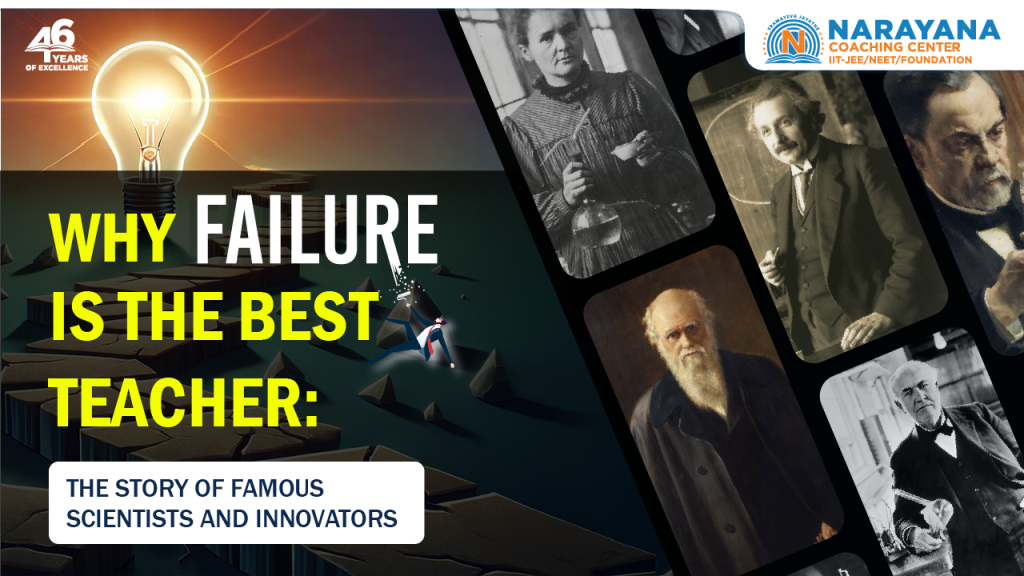
Failure is often perceived as a setback, but history has repeatedly proven that it can be the greatest teacher. Many of the most successful scientists and innovators endured countless failures before making groundbreaking discoveries. Their journeys highlight the power of persistence, learning from mistakes, and resilience. In this blog, we explore how famous figures like Thomas Edison, Albert Einstein, and Steve Jobs turned their failures into stepping stones for success.
The Power of Failure in Science and Innovation
Failure in science and innovation is not the end but a crucial step towards discovery. Many of the world’s most transformative ideas emerged after numerous failed attempts. This process of trial and error not only refines ideas but also builds resilience and strengthens character.
Thomas Edison: The Light Bulb’s Long Road to Success
Thomas Edison’s journey to inventing the practical electric light bulb is a quintessential story of persistence through failure. Edison reportedly tested more than 1,000 materials for the filament before finding the right one.
Lessons from Edison’s Failures:
- View failure as data collection.
- Continuously refine ideas through repeated testing.
- Never give up on a vision despite repeated setbacks.
Albert Einstein: Overcoming Academic Struggles
Albert Einstein, one of the greatest physicists of all time, was perceived as a slow learner in his early years. He struggled with traditional education and even failed the entrance exam to the Swiss Federal Polytechnic School on his first attempt.
What We Learn from Einstein:
- Academic failure does not define intelligence.
- Unconventional thinking often leads to groundbreaking discoveries.
- Perseverance is key to success in any field.
Marie Curie: Battling Gender Bias and Research Failures
Marie Curie, the first woman to win a Nobel Prize, faced significant obstacles in her scientific journey. Her groundbreaking research in radioactivity involved countless failed experiments and personal hardships, including exposure to hazardous materials that ultimately affected her health.
Key Takeaways from Curie:
- Break barriers and keep striving despite societal challenges.
- Scientific discovery requires patience and relentless experimentation.
- Success often comes at a personal cost but can change the world.
Steve Jobs: The Power of Being Fired from Apple
Steve Jobs, co-founder of Apple, was fired from his own company in 1985. However, he turned this setback into an opportunity for innovation, leading to the creation of Pixar and the eventual revival of Apple with revolutionary products like the iPhone.
Lessons from Steve Jobs:
- Failure can be a catalyst for reinvention.
- Innovation comes from embracing setbacks.
- Passion fuels success more than initial circumstances.
Nikola Tesla: Unfulfilled Genius with Unmatched Vision
Nikola Tesla, a brilliant inventor, faced financial and business failures despite his groundbreaking contributions to electrical engineering. His ideas, often ahead of their time, were met with scepticism, and he struggled to commercialise his inventions.
What We Can Learn from Tesla:
- Great ideas may not be immediately recognised but still have value.
- Financial struggles do not equate to intellectual failure.
- True innovation often faces initial resistance.
James Dyson: 5,126 Prototypes Before Success
James Dyson spent years developing his revolutionary bagless vacuum cleaner, creating over 5,000 failed prototypes before achieving success. His perseverance led to a billion-dollar company that transformed the home appliance industry.
Dyson’s Key Takeaways:
- Repeated failure leads to improved innovation.
- Real-world testing is essential for product development.
- Believe in your ideas, even in the face of rejection.
The Wright Brothers: Rewriting Aviation History
The Wright brothers, Orville and Wilbur, endured years of failed attempts before achieving powered flight in 1903. They meticulously studied aerodynamics, learning from each failure until they built the first successful aeroplane.
Lessons from the Wright Brothers:
- Failure is a learning opportunity, not a dead end.
- Hands-on experience is crucial for innovation.
- Persistence in the face of scepticism leads to breakthroughs.
Conclusion: Why is Failure the Ultimate Teacher?
Failure is not an obstacle but a stepping stone to success. The stories of these scientists and innovators prove that resilience, persistence, and the ability to learn from mistakes are essential for groundbreaking achievements. Instead of fearing failure, embrace it as an essential part of growth.
FAQs
1. Why is failure important in innovation?
Failure allows individuals to refine ideas, test theories, and improve designs through trial and error, ultimately leading to success.
2. How did Thomas Edison view failure?
Edison saw failure as part of the learning process, famously stating, “I have not failed. I’ve just found 10,000 ways that won’t work.”
3. What can we learn from Marie Curie’s struggles?
Curie’s perseverance in the face of gender discrimination and scientific obstacles teaches us that determination and passion can overcome any challenge.
4. How did Steve Jobs turn failure into success?
After being fired from Apple, Jobs founded Pixar and later returned to Apple, leading the company to unprecedented success with revolutionary products.
5. What is the main takeaway from the stories of these innovators?
The key lesson is that failure is not an endpoint but a crucial step towards success. Each failure provides valuable insights that pave the way for future success.
